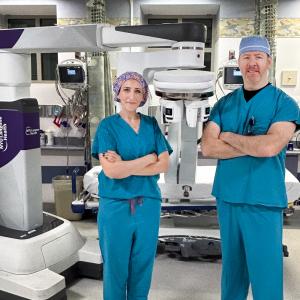
Dr. Bernstein and Dr. Gross collaborate to treat a patient using a robotic endoscope.
Photo: Karsten Moran
Each year, an estimated 140,000 individuals in the United States are diagnosed with colorectal cancer, a malignancy that often develops from a benign polyp into cancer over time. Screening by colonoscopy allows for the detection and removal of polyps, and therefore aids both the prevention and early detection of colorectal cancers. However, when colorectal polyps or other lesions are too large or difficult to remove by colonoscopy, surgery is required. Now, an innovative new option is available: a robotic scope that enables the physician to successfully remove lesions that cannot be removed by endoscopy without the patient undergoing surgery.
Through a collaboration between the Division of Colorectal Surgery and the Division of Gastroenterology and Hepatology, physicians at NYU Langone Health were the first in New York State to use the Flex® Robotic System within the gastrointestinal tract. Together, colorectal surgeon Mitchell Bernstein, MD, director of the Division of Colorectal Surgery, and gastroenterologist Seth A. Gross, MD, removed a large, premalignant rectal lesion in a woman who was later discharged on the same day.
“This is the first time a robotic platform was incorporated into gastrointestinal endoscopy,” says Dr. Gross, also an associate professor in NYU Langone’s Department of Medicine. “At a time when technology and advancement in endoscopy is rapidly improving, our division is committed to studying and utilizing the best technologies available to care for patients.”
Patients with large lesions—whether benign, premalignant, or potentially malignant—in the GI tract often undergo surgery to remove the diseased anatomy. The robotic platform combines the principles of both endoscopy and minimally invasive surgery for luminal gastrointestinal procedures.
“As surgeons, we continually strive to enhance our techniques, to provide better results for our patients while minimizing complications, decreasing pain, and speeding up recovery,” said Dr. Bernstein, also an associate professor in NYU Langone’s Department of Surgery. “As a proponent of minimally invasive and robotic surgery, I appreciate the value of technology that treats disease without creating a traditional incision, thereby reducing scarring, recovery time, and risk of infection, while enhancing patient experience.”
How the Medrobotics Flex Robotic System Works
During the procedure, a flexible robotic scope is inserted into the anus under general anesthesia. The physician advances the endoscope, which contains a high-definition, three-dimensional camera, to the site of the lesion by using a robotic console. Once in position, the scope creates a stable surgical platform through which flexible instruments can pass. Physicians remove the lesion without making any cuts through a patient’s skin.
The Flex® Robotic System has been widely recognized for advances in robotic technology, receiving the Best-in-Show Award at the 2016 Medical Design Excellence Awards and a Best New Product Award at the 2017 Edison Awards.
The U.S. Food and Drug Administration (FDA) cleared the Medrobotics® Flex® Robotic System for colorectal application in the anus, rectum, and distal colon in May 2017. The procedure is covered by most private insurance plans and Medicare. Dr. Bernstein and Dr. Gross have no disclosure of any commercial interest or financial support from Medrobotics®.
Media Inquiries
Rob Magyar
Phone: 212-404-3591
robert.magyar@nyulangone.org

